20
Loyal British Subjects receive 100 Acres of Land after the War of IndependenceThe government of the day provided a unique way of calculating land for Black Refugees. Meyler, in writing "A Stolen Life," uncovered some rather interesting interpretations of the allotment of land. Sir John Johnson, in charge of the land grants, argued that each slave should receive 50 acres of land. Had Johnson had his way, those land grants would then have been turned over to the slave's owner. Under this method of allotment, Johnson himself would have received an additional 50 acres for each of his 11 enlisted slaves. In the end, freedom seeking slaves like Pierpoint received land only at the discretion of local authorities.
Meyler's "A Stolen Life" highlights a number of Loyalists who brought in slaves from the United States:
- Major Peter van Alstine near Kingston (10 slaves)
- Peter Russell (possibly 99 slaves)
- William Jarvis
- Robert Isaac Dey Gary
- Peter Robinson
It also notes that during a raid to the American side, Sir John Johnson brought back 30 slaves, some of whom belonged to him when he lived in the US. One slave owner, a Captain Matthew Elliott living near Amherstburg, had 60 slaves to tend 3,000 acres of land. The total number of such refugees is difficult to assess, but the British Government paid £50,000 to the State of Virginia as compensation for the African slaves who escaped to the British side. Considering the value of each slave at a possible £10, it would mean that 5,000 people escaped to the British jurisdiction from Virginia alone.
21
Typical Poster Advertising for Slaves18th Century
No location applicable
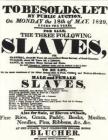 Credits:
Credits:Norval Johnson Heritage Centre
22
War of 1812: Formation of Niagara's Coloured CorpsPierpoint, now well into his 60s, joined other Africans to do battle against slave owning Americans. The Coloured Corps was established with the controversial white Captain Robert Runchey in command. Traditionally, the British required potential officers to buy their rank, which may explain in part why no black officers were appointed. Other blacks did earn the rank of non-commissioned officers who were responsible for the operations of the Corps. Unlike many of the militia's of the day, the Coloured Corps were actually incorporated which meant they had an entitlement to six months pay at the end of their service.
23
There is good indication that the men of the Coloured Corps were used as skirmishers who took hills and/or forested ground. Individual soldiers fired while another row behind were reloading and preparing to fire again. Rows exchanged roles, moving forward as rounds were continuously fired at the enemy. The weapon being fired was the single shot Brown Bess but may have been substituted with other smooth bore hunting rifles. Both rifles required a great skill to have any useful results in battle. Meyler's book suggests that in 1813 the Coloured Corps were assigned Artificers which could have meant military construction crews.24
One of the few Coloured Corps plaques in the area20 July 2009
Niagara-on-the-Lake, Ontario, Canada
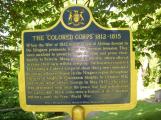 Credits:
Credits:James Black
25
Only star-shaped earthenworks in North America, Fort Mississauga, Niagara-on-the-Lake20 July 2009
Niagara-on-the-Lake, Ontario, Canada
 Credits:
Credits:James Black
26
Earthen Works around Fort Mississauga, built by the Coloured Corps20 July 2009
Niagara-on-the-Lake, Ontario, Canada
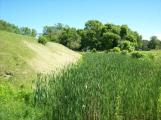 Credits:
Credits:James Black
27
General Brock was a simple target for any Americans soldier as he rode his horse towards the American lines. His colourful uniform and officer's insignia clearly marked him as a critical target. After Brock's death the Coloured Corps, of approximately 30 blacks along with Aboriginal soldiers, using the skirmishing technique, focused their attention on the Americans. Their efforts could have drawn the Americans' attention away from reinforcements approaching from the rear, behind the earthen fortification at the top of the escarpment.28
Coloured Corps Honour Guard escorted General Isaac Brock's remains to rest under monument site20 July 2009
Queenston Heights Park, Ontario, Canada
 Credits:
Credits:James Black
29
What happened to Prisoners during the conflicts between the United States and Upper Canada?There is clearly a distinction between the treatment of the Black soldiers and the soldiers of upper class society. Jack William's, biographer of William Hamilton Merritt, tells about the treatment of this captured white officer. Merritt was placed on a kind of prisoner of war 'parole' in Greenbush, Massachusetts. Merritt was allowed to take lengthy rides in the country, play billiards, participate in special dinners and even attend church with attractive young ladies. Not surprisingly, Merritt married an American woman within days of his release at the close of the war. Merritt's only complaint was boredom!
In stark contrast, according to the book "Broken Shackles," also by Meyler and Meyler, a Black soldier who was captured after a battle near Canard River, close to Amherstburg in Upper Canada, was sold into slavery during the War of 1812. This apparently was common practice with captured Black soldiers. In the case of the Canard River prisoner of war the Americans even rounded up his family and sold all of them as slaves. Black soldiers and their wives and children were never heard from again.
30
Typical Cotton Plantation Field in South Carolina11 November 2008
South Carolina, United States
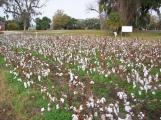 Credits:
Credits:James Black
31
The Merritt Monument offers no recognition of the Coloured Corps20 July 2009
St Catharines, Ontario, Canada
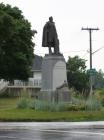 Credits:
Credits:James Black
32
Fort MississaugaThe original Fort George was destroyed during the War of 1812. After some assessment by officers of the day, a new site was selected and a secure smaller fortification was ordered constructed with a dry ditch in a unique star-shaped earthen works. The Coloured Corps, during war conditions, built this much smaller but more defendable fort. Much of the original work of 1813-14 stands to this very day as Fort Mississauga in Niagara-on-the-Lake. The Coloured Corps' contribution and loyalty was rewarded in 1824 when Brock's body was moved to the present monument in Queenston, Ontario, with an accompanying honour guard of 6 members of the Coloured Corps walking their horses beside the carriage that carried Brock's remains. (Meyler)
33
Fort Mississauga National Park22 July 2009
Niagara-on-the-Lake, Ontario, Canada
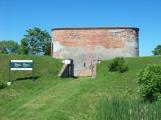 Credits:
Credits:James Black